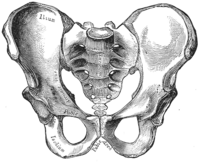
Photo from wikipedia
OBJECTIVE To describe an ultrasound-guided lateral quadratus lumborum (LQL) block technique and the spread characteristics of lidocaine-dye injected in the LQL plane using a transversal (LQL-T) or a longitudinal (LQL-L)… Click to show full abstract
OBJECTIVE To describe an ultrasound-guided lateral quadratus lumborum (LQL) block technique and the spread characteristics of lidocaine-dye injected in the LQL plane using a transversal (LQL-T) or a longitudinal (LQL-L) approach. STUDY DESIGN Experimental anatomic study. ANIMALS A total of eight canine cadavers. METHODS Bilateral ultrasound-guided injections in the fascial plane lateral to the quadratus lumborum muscle and medial to the thoracolumbar fascia (LQL plane) with the needle directed at the first lumbar (L1) transverse process were performed using lidocaine-dye (0.3 mL kg-1). Anatomical dissection determined the dye distribution, sympathetic trunk staining and number of spinal nerves stained circumferentially >1 cm. RESULTS The LQL fascial plane was ultrasonographically recognized in all cadavers and filled with lidocaine-dye in all eight cadavers with the LQL-T approach and in six with LQL-L. The injectate spread ventral to the lumbar transverse processes, around the quadratus lumborum muscle and dorsal to the transversalis fascia, affecting the ventral branches of the spinal nerves and the sympathetic trunk. A median (range) of 4 (3-5) and 3 (0-4) ventral branches of the thoracolumbar nerves were dyed with LQL-T and LQL-L approaches, respectively (p = 0.04). The most cranial nerve stained was the twelfth thoracic (T12) with the LQL-T approach and T13 with LQL-L, and the most caudal was L3 with both approaches. The incidence of sympathetic trunk staining was significantly higher using LQL-T (six injections) compared with LQL-L (one injection; p = 0.04). Dye was not observed in the lumbar plexus, epidural space or abdominal cavity. CONCLUSIONS AND CLINICAL RELEVANCE Ultrasound-guided LQL-T approach resulted in a more consistent spread toward the spinal nerves and sympathetic trunk compared with LQL-L approach. Further studies are necessary to assess the LQL block effectiveness and success rate in live dogs.
Journal Title: Veterinary anaesthesia and analgesia
Year Published: 2020
Link to full text (if available)
Share on Social Media: Sign Up to like & get
recommendations!